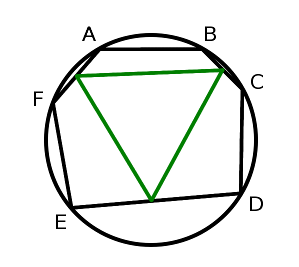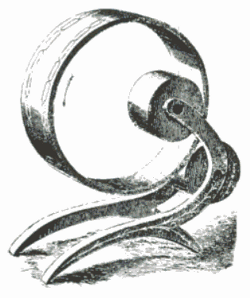
Prove that, if we choose nine vertices of a regular icosagon, some three of these will form an isosceles triangle.

Prove that, if we choose nine vertices of a regular icosagon, some three of these will form an isosceles triangle.
If a pane of green glass gives the things behind it a green colour, it turns white to green, red to black, yellow to greenish yellow, blue to greenish blue. The white pane should, therefore, make everything whitish, i.e. it should make everything pale; and, then why shouldn’t it turn black to grey? — Even a yellow glass makes things darker, should a white glass make things darker too?
— Wittgenstein, Remarks on Colour, 1977
‘Our Second Experiment,’ the Professor announced, as Bruno returned to his place, still thoughtfully rubbing his elbows, ‘is the production of that seldom-seen-but-greatly-to-be-admired phenomenon, Black Light! You have seen White Light, Red Light, Green Light, and so on: but never, till this wonderful day, have any eyes but mine seen Black Light! This box,’ carefully lifting it upon the table, and covering it with a heap of blankets, ‘is quite full of it. The way I made it was this — I took a lighted candle into a dark cupboard and shut the door. Of course the cupboard was then full of Yellow Light. Then I took a bottle of Black ink, and poured it over the candle: and, to my delight, every atom of the Yellow Light turned Black! That was indeed the proudest moment of my life! Then I filled a box with it. And now would any one like to get under the blankets and see it?’
— Lewis Carroll, Sylvie and Bruno Concluded, 1893

In 1964 Canadian writer Graeme Gibson bought a parrot in Mexico. The bird, which Gibson named Harold Wilson, was bright and affectionate at first, but he seemed to grow lonely in the dark Canadian winter, so in the spring Gibson made arrangements to donate him to the Toronto Zoo. At the aviary Gibson carried Harold into the cage that had been prepared for him, placed him on a perch, said his goodbyes, and turned to go.
“Then Harold did something that astonished me. For the very first time, and in exactly the voice my kids might have used, he called out ‘Daddy!’ When I turned to look at him he was leaning towards me expectantly. ‘Daddy’, he repeated.
“I don’t remember what I said to him. Something about him being happier there, that he’d soon make friends. The kind of things you say to kids when you abandon them at camp. But outside the aviary I could still hear him calling ‘Daddy! Daddy!’ as we walked away. I was shattered to discover that Harold knew my name, and that he did so because he’d identified himself with my children.
“I now believe he’d known it all along, but was using it — for the first time — out of desperation. Both Konrad Lorenz and Bernd Heinrich mention instances of birds calling out the private names of intimates when threatened by serious danger. I am no longer surprised by such information. We think of our captive birds as our pets, but perhaps we are theirs as well.”
(From Gibson’s Perpetual Motion, 1982.)
“If you choose to represent the various parts in life by holes upon a table, of different shapes, — some circular, some triangular, some square, some oblong, — and the persons acting these parts by bits of wood of similar shapes, we shall generally find that the triangular person has got into the square hole, the oblong into the triangular, and a square person has squeezed himself into the round hole. The officer and the office, the doer and the thing done, seldom fit so exactly, that we can say they were almost made for each other.” — Sydney Smith

Suppose the Grand Canyon were man-made. It could have been formed (though it wasn’t) by agricultural or industrial erosion; the results of poor farming methods can look very similar — artificial badlands — if on a smaller scale. Would this hideous scar on the fair face of the earth still be a national park? Would anyone visit it other than groups of awed schoolchildren studying Environmental Destruction, absorbing the dreadful lesson of what can happen to a desert raped by human exploiters? Strip mining can produce spectacular and dramatic landscapes. W.H. Auden loved the lead-mining landscapes of Cornwall above all others; the evocative and aromatic hillsides of the Mediterranean, with their olives, sages, thyme, and dwarf conifers, are a result of centuries of deforestation, goat herding, and the building of roads and cities.
— Frederick Turner, “Cultivating the American Garden: Toward a Secular View of Nature,” Harper’s, August 1985

Inscribe a hexagon in a unit circle such that AB = CD = EF = 1.
Now the midpoints of BC, DE, and FA form an equilateral triangle.
See A Better Nature.
In a historic passage Mallarmé describes the terror, the sense of sterility, that the poet experiences when he sits down to his desk, confronts the sheet of paper on which his poem is supposed to be composed, and no words come to him. But we might ask, why could not Mallarmé, after an interval of time, have simply got up from his chair and produced the blank sheet of paper as the poem that he sat down to write? Indeed, in support of this, could one imagine anything that was more expressive of, or would be held to exhibit more precisely the poet’s feelings of inner devastation than the virginal paper?
— Richard Wollheim, “Minimal Art,” in Minimal Art, ed. Gregory Battcock, 1968

Arthur W.J.G. Ord-Hume calls this “the most graceful and simple perpetual motion machine of all time.” It was offered by American inventor F.G. Woodward in the 19th century. A heavy wheel is mounted between two rollers so that the wheel’s weight causes it to roll continuously in the direction of the arrow.
Or so Woodward hoped. Ord-Hume notes that the principle required the left half of the wheel always to be heavier than the right half. “Sadly, it wasn’t.”
There is at Columbia University’s Arden House Conference Center a statue of a cat in bronze. It stands on a floor at the head of a stairway that leads into a common room at a lower level. Presumably it is of some value, or believed to be … inasmuch as the managers have chained it to the railing — to forestall theft, I suppose, as if it were a television set in a squalid motel. Such might be the obvious interpretation. But I am open to the suggestion that it is not a chained sculpture of a cat but a sculpture of a chained cat, one end of which is wittily attached to a piece of reality. … Of course what we take to be a bit of reality can in fact be part of the work, which is now a sculpture of a cat-chained-to-an-iron-railing, though the moment we allow it to be a part of the work, where does or can the work end? It becomes a kind of metaphysical sandpit, swallowing the universe down into itself.
— Arthur Danto, The Transfiguration of the Commonplace, 1981

During the filming of Planet of the Apes in 1967, Charlton Heston noted “an instinctive segregation on the set. Not only would the apes eat together, but the chimpanzees ate with the chimpanzees, the gorillas ate with the gorillas, the orangutans ate with the orangutans, and the humans would eat off by themselves. It was quite spooky.”
James Franciscus noticed the same thing filming Beneath the Planet of the Apes in 1969. “During lunch I looked up and realized, ‘My God, here is the universe,’ because at one table were all the orangutans eating, at another table were the apes, and at another table were the humans. The orangutan characters would not eat or mix with the ape characters, and the humans wouldn’t sit down and eat with any one of them.
“I remember saying, ‘Look around — do you realize what’s happening here? This is a little isolated microcosm of probably what’s bugging the whole world. Call it prejudice or whatever you want to call it. Whatever’s different is to be shunned or it’s frightening or so forth.’ Nobody was intermingling, even though they were all humans underneath the masks. The masks were enough to bring out our own little genetic natures of fear and prejudice. It was startling.”
(From Joe Russo and Larry Landsman, Planet of the Apes Revisited, 2001.)